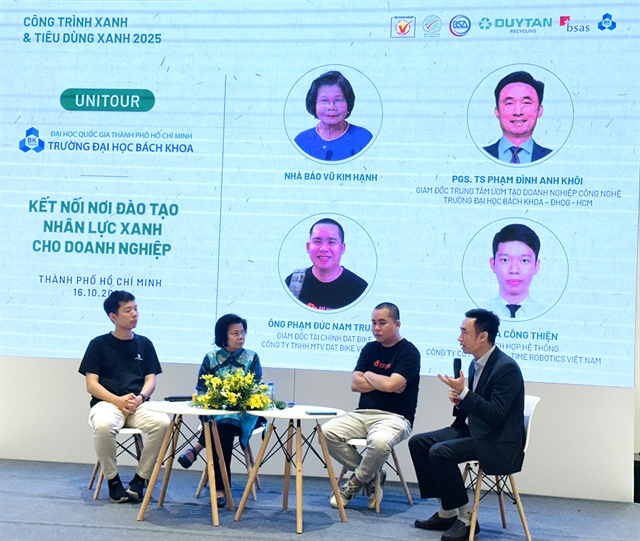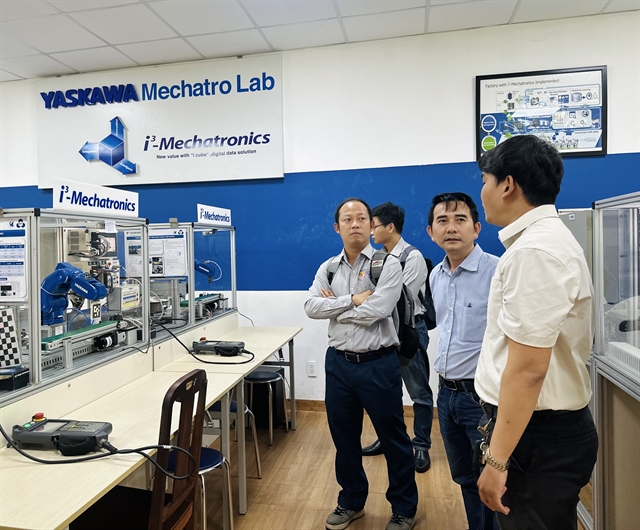Connecting training institutions with businesses and linking knowledge with practice are essential for sustainable growth, attendees heard said at a panel discussion during the Uni Tour event held on Thursday in HCM City.

HCM CITY — Connecting training institutions with businesses and linking knowledge with practice are essential for sustainable growth, attendees heard said at a panel discussion during the Uni Tour event held on October 16 in HCM City.
The Uni Tour, themed “Connecting Green Workforce Training for Businesses,” was co-organised by the High-Quality Vietnamese Goods Business Association (HVNCLC) and the Business Studies and Assistance Centre (BSA) at the HCM City University of Technology (HCMUT) under Việt Nam National University-HCM City (VNU-HCM).
The event brought together more than 20 companies from the HVNCLC ecosystem, representatives from R&D institutes, lecturers, hundreds of students, and over 30 journalists from national and local media outlets.
Vũ Kim Hạnh, chairwoman of HVNCLC, highlighted the crucial role of linking education with industry to drive sustainable development.
“Collaboration between academia, business, and technology can turn research and innovation into a driving force for Việt Nam’s sustainable industrial growth,” she said.
She said Uni Tour creates multiple benefits: for businesses, it offers opportunities to find talent, commission research, and co-develop green, circular technology projects; for students, it provides practical exposure and career insights; and for the media, it opens a platform to showcase stories of innovation and green transformation.
As one of the country’s top engineering and research institutions, HCMUT operates more than 10 advanced R&D and technology transfer centres focused on key green transition areas — including artificial intelligence, automation, renewable energy, sustainable materials, and circular production.
Huỳnh Kỳ Phương Hạ, vice president of HCMUT, said green transformation is no longer a “nice-to-have” option but a matter of survival for enterprises seeking competitiveness, compliance with global market standards, and contribution to national sustainability goals.
“To move from strategy to action, we need a co-creation ecosystem that unites academia, business, and the media,” he said.
In this model, businesses define practical challenges, universities provide knowledge and technological solutions, and the media amplifies success stories and broadens social impact.
HCMUT aims to position itself as a leading hub for education, research, and technology transfer, where academic knowledge is transformed into real-world solutions.
Through Uni Tour, the university seeks deeper partnerships in technical consulting, joint R&D, green innovation, and flexible training programmes tailored to business needs.
“With the spirit of ‘from strategy to action,’ we believe today’s handshakes will soon turn into concrete projects – optimised production lines, greener products, and generations of HCMUT engineers ready to lead Việt Nam’s green transformation,” Hạ said.

Phạm Đình Anh Khôi, director of HCMUT’s Center for Technology Business Incubation, said the Government has issued strategic policies to boost innovation and create breakthroughs for educational institutions engaged in research and technology transfer.
He said the “triple helix” collaboration model – connecting universities, businesses, and the government – enhances the effectiveness and sustainability of technological innovation, digital transformation, and green workforce development.
Phạm Đức Nam Trung, chief financial officer of Dat Bike Vietnam Co., Ltd., praised the university’s strong support for enterprises through training and cooperation, noting that around 50 per cent of his engineers graduated from HCMUT.
“Thanks to partnerships with several universities, Dat Bike successfully launched its first electric motorbike model and continues to expand its product line,” he said.
Hà Công Thiện, system integration engineer at Real-Time Robotics Vietnam, shared his experience presenting Vietnamese-made industrial drones in the US.
“Executives from billion-dollar companies were surprised and impressed by the quality of drones developed by Vietnamese engineers,” he said, noting that many of the drones’ components and technologies originated from research at HCMUT.
His company plans to strengthen collaboration with the university by funding research, offering project topics for students, and providing internships at its facilities.
Beyond high-tech projects like Dat Bike and Real-Time Robotics, HCMUT has also helped local cooperatives and farmers improve agricultural product value through research-based innovation.
The Mỹ Long Seedless Lime Cooperative in Đồng Tháp Province initially struggled with product quality and export competitiveness.
After receiving technology transfer support from HCMUT, especially for honey-lime concentrate, the cooperative's products have not only secured a strong domestic market position but are now being exported.
The Uni Tour also featured a Campus Tour, allowing participants to explore laboratories, R&D spaces, and pilot workshops where students and researchers are developing technologies ranging from autonomous robots to renewable energy systems and sustainable materials.
The event is part of the 2025 “Green Building – Green Consumption” initiative launched by HVNCLC to promote green transition, knowledge sharing, and sustainable collaboration between universities and enterprises across Việt Nam. — VNS





